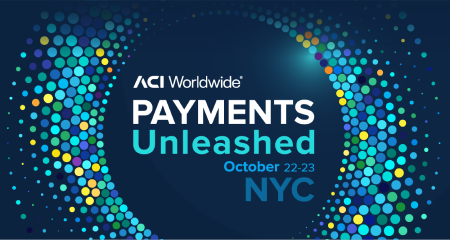- Solutions
- Banking
-
- ACI ConneticUnified cloud payments platform
- AcquiringDigital acceptance, merchant management
- IssuingDigital payments and accounts issuing
- Fraud managementReal-time enterprise fraud management
- RTGS / Wires and cross-borderMulti-bank, multi-currency processing
- Real-time, instant paymentsComplete real-time payments processing
- ATMsSelf-service, omnichannel digital experience
- Central infrastructureInnovative real-time payment infrastructure
- NEW Redefining the payments hub: Solving today’s banking payment challenges
-
- Merchant payments
- ACI Payments Orchestration PlatformEnable customer journeys across commerce channels, accept payments, prevent fraud and optimize your payments journey
- In-storeDynamic, modern in-store payments
- eCommerceOnline and mobile payments
- Alternative payment methodsGive more ways to pay
- Value-added servicesEngagement, optimization and reporting
- Fraud managementEnd-to-end fraud orchestration
- Risk, security, and complianceAchieve and maintain compliance
- NEW Datos names ACI Worldwide best-in-class in payments orchestration
- Industries we serve
- Billing and bill payments
- ACI SpeedpayDrive customer satisfaction with the widest range of bill pay options in the industry.
- Bill payment APIs and SDKsOutsource bill payment processing
- Fraud managementAI-based fraud orchestration technology
- Alternative payment methodsGive more ways to pay
- Loan servicingPreferred loan payment options
- Treasury managementStreamline and integrate your back office
- Automated debt collectionImprove your collections process
- Digital walletsManage digital cards and payments
- PCI compliance and securityAchieve and maintain PCI compliance
- Industries We Serve
- Fraud management and payments intelligence
- Fraud managementFraud solutions to minimize risk and prevent fraud
- Fraud management for bankingEnterprise-wide fraud prevention
- Anti-money launderingStay ahead of money-laundering schemes
- Robotic process automationAutomate payment processing operations
- Fraud management in the cloudProtecting your business in the cloud
- Fraud management for merchantsProtect payments from end to end
- ChargebacksPrevent chargebacks before they happen
- SCA complianceAchieve and maintain SCA compliance
- Digital identity solutionsConfirm identities with behavioral analytics
- NEW Scamscope fraud report: APP scam trends from around the globe
-
- ACI ConneticUnified cloud payments platform
- AcquiringDigital acceptance, merchant management
- IssuingDigital payments and accounts issuing
- Fraud managementReal-time enterprise fraud management
- RTGS / Wires and cross-borderMulti-bank, multi-currency processing
- Real-time, instant paymentsComplete real-time payments processing
- ATMsSelf-service, omnichannel digital experience
- Central infrastructureInnovative real-time payment infrastructure
- NEW Redefining the payments hub: Solving today’s banking payment challenges
- ACI Payments Orchestration PlatformEnable customer journeys across commerce channels, accept payments, prevent fraud and optimize your payments journey
- In-storeDynamic, modern in-store payments
- eCommerceOnline and mobile payments
- Alternative payment methodsGive more ways to pay
- Value-added servicesEngagement, optimization and reporting
- Fraud managementEnd-to-end fraud orchestration
- Risk, security, and complianceAchieve and maintain compliance
- NEW Datos names ACI Worldwide best-in-class in payments orchestration
- Industries we serve
- ACI SpeedpayDrive customer satisfaction with the widest range of bill pay options in the industry.
- Bill payment APIs and SDKsOutsource bill payment processing
- Fraud managementAI-based fraud orchestration technology
- Alternative payment methodsGive more ways to pay
- Loan servicingPreferred loan payment options
- Treasury managementStreamline and integrate your back office
- Automated debt collectionImprove your collections process
- Digital walletsManage digital cards and payments
- PCI compliance and securityAchieve and maintain PCI compliance
- Industries We Serve
- Fraud managementFraud solutions to minimize risk and prevent fraud
- Fraud management for bankingEnterprise-wide fraud prevention
- Anti-money launderingStay ahead of money-laundering schemes
- Robotic process automationAutomate payment processing operations
- Fraud management in the cloudProtecting your business in the cloud
- Fraud management for merchantsProtect payments from end to end
- ChargebacksPrevent chargebacks before they happen
- SCA complianceAchieve and maintain SCA compliance
- Digital identity solutionsConfirm identities with behavioral analytics
- NEW Scamscope fraud report: APP scam trends from around the globe
- Company
- Customers
- Partners
On this page
The evolution of eCommerce has been a story of balancing simplicity and security. As consumers increasingly demand fast, frictionless payment options, merchants must keep pace or risk cart abandonment and missed sales opportunities. Click to Pay, developed by EMVCo and based on Secure Remote Commerce (SRC), has emerged as a frontrunner in the world of alternative payment methods for its ability to solve this challenge. With 70 million global registrations (and counting) across 23 countries, and backing from all major card brands, Click to Pay is no longer a nascent technology, but a transformative force redefining digital transactions.
Speed and security, all in one
If you’ve ever sighed at the sight of a long checkout form or debated whether saving your card in another browser was worth the risk, Click to Pay is here to change the narrative.
Click to Pay offers a quick, easy, and secure one-click payment method for online shopping. After registering, users can make purchases on any eCommerce site displaying the Click to Pay logo without entering card details.
But Click to Pay is more than a means of increasing consumer convenience; it’s a solution to the age-old issue of balancing payment speed, convenience, and security.
EMVCo generates and stores a unique token representing the consumer’s credentials. Whenever a consumer initiates a transaction using Click to Pay, they must authenticate their identity with a one-time password. Additionally, a unique cryptogram is automatically generated and linked to the token. If the token is reused, the cryptogram will not match, and the transaction will be rejected.
At no point does the merchant have access to the consumer’s card credentials, adding a layer of security to every transaction and giving consumers peace of mind when shopping with brands they may be less familiar with. Click to Pay’s full backing from trusted card brands, including Visa, Mastercard, American Express, and Discover, further assures its legitimacy and security.
Why Click to Pay is the right choice for merchants
The benefits of Click to Pay go far beyond just adding another button to your checkout page. It solves several pain points that online merchants face daily:
It earns consumer trust from day one.
Right or wrong, first-time visitors to your site may be hesitant to purchase for fear of exposing their card credentials . Trust, especially with new merchants, can make or break a sale. 25% of consumers say that their primary reason for abandoning a cart during checkout is because they don’t trust the site with their credit card information.
Click to Pay eliminates this potential hurdle by enabling consumers to checkout securely without having to enter their information directly, so your relationship starts on the right foot.
What’s more, the EMVCo name behind Click to Pay carries weight. Consumers know it from the security of their chip-enabled cards, and that recognition can make all the difference when deciding whether to complete a transaction or abandon their cart.
It reduces interchange fees.
Click to Pay can significantly reduce interchange fees through tokenization. Transactions that used tokens instead of raw card data often qualify for interchange fees similar to or the same as those offered for network token transactions, which are lower by default.
Merchants not only enjoy lower costs for overall payment processing but reap all the reward network tokens have to offer, including greater transaction security and reduced fraud risk.
It reduces your PCI compliance burden.
Payment Card Industry Data Security Standard (PCI DSS) compliance can be challenging for merchants. Meeting its stringent requirements, which include encryption protocols and vulnerability testing, can require substantial effort.
This is where Click to Pay shines. Rather than processing or storing cardholder data, merchants shift the compliance burden to EMVCo, which replaces consumers’ credentials with tokens stored in an encrypted vault. This reduces the risk of penalties should something go wrong.
It’s fast for you and your customers.
Another common reason for cart abandonment is a long or complicated checkout process, with 22% of consumers citing it as a major pain point. Click to Pay transforms this experience, offering a one-click option that’s proven to reduce friction at checkout. Merchants can easily integrate Click to Pay into their payment process, whether they are large enterprises or small businesses using a payment service provider.
But wait — what about browser-saved credentials?
If you’re thinking, “Consumers can already save their card details in their browser, why would they need to Click to Pay?”, you’re not alone. It’s a common objection to implementing Click to Pay, but the answer’s simple: Browser-stored credentials lack the sophisticated security measures Click to Pay offers.
With Click to Pay, card details aren’t just saved — they’re tokenized. Even if a hacker were to intercept the transaction, that token would be useless to them. And even if they did attempt to use that token, without a matching cryptogram, the transaction would be automatically declined. Consumers can use Click to Pay across devices without needing to sync their browser settings, providing a convenient option for users.
While we’re at it, let’s address a few other concerns merchants have raised about Click to Pay:
● “I already have a one-click payment option. Why add another?” Having multiple options provides flexibility. Offering various payment methods can remove barriers to purchase. Click to Pay works alongside existing payment methods such as PayPal or Apple Pay, making it available for different types of shoppers.
● “How does Click to Pay impact customer loyalty?” Click to Pay isn’t just a checkout tool, it’s a way to build trust with new or prospective customers. When first-time shoppers see that you offer a secure payment option, they’re more likely to convert. And when returning customers realize how easy it is to use, they’re more likely to make another purchase.
Customers who are not already using Click to Pay can sign up on your website during checkout. This simplifies the onboarding process and enhances their connection to your brand by providing an easy on-site registration experience.
At a tipping point
We’re at a tipping point for Click to Pay adoption. Backed by all major card networks, with over 70 million registrations and rapidly growing consumer awareness, Click to Pay is well on its way to becoming a default expectation in online checkout experiences. Merchants who adopt Click to Pay can position themselves as leaders in customer-centric innovation. The best part? Implementation is quick, with immediate benefits: higher conversion rates, reduced fraud risk, and increased consumer trust.
What’s next?
As Click to Pay gains traction, its potential for growth and innovation is enormous. Future enhancements could include deeper integrations with loyalty programs, advanced fraud detection measures, and even faster authentication processes.
Looking ahead, we expect acquiring banks to play a pivotal role in expanding Click to Pay’s reach. Soon, customers will likely be able to sign up for Click to Pay directly through their bank’s app or website while managing their card information. This streamlined enrollment process — embedded in a trusted financial environment — has the potential to dramatically increase registration volumes, bringing millions of new users into the Click to Pay ecosystem. For merchants, this translates to a growing pool of consumers ready to check out quickly, securely, and confidently.
Click to Pay with ACI Worldwide
Getting started with Click to Pay couldn’t be easier. We’ve streamlined the process by pre-integrating the necessary APIs into our platform, eliminating technical complexity. Let’s talk today about how you can implement faster, more secure checkout experiences across all platforms using the latest payment innovations.




